
三菱会社の昔の大名の家には、入り口に警備員がいます。もちろん、その日陰のところから中に入ってみたいです。
Of course, I want to go into this shady spot.



I like how the misters on these giant green columns benefit the plants and overheated people below. There’s also a lovely effect of plants and mist against early 20th century brick, preserved as part of the Marunouchi Brick Square development by Mitsubishi.

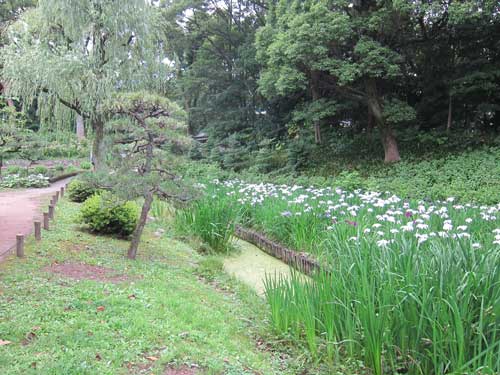
深川の清澄庭園で、きれいな菖蒲が咲いていました。この日本庭園は江戸時代に作られて、明治時代に三菱の創設者が世話をしました。東日本大震災のせいで、石灯ろうが倒れていました。
Visiting Chris and Eiko one recent Sunday, I had the chance to visit Kiyosumi garden in Fukagawa, and see the irises in bloom. Kiyosumi (清澄庭園) dates back to early Edo, and was then owned by the Mitsubishi founder in the Meiji period. It’s a lovely strolling garden with a pond. I had forgotten that June is the month to see irises, and I love how they are used in traditional Japanese gardens with running water and pine trees.
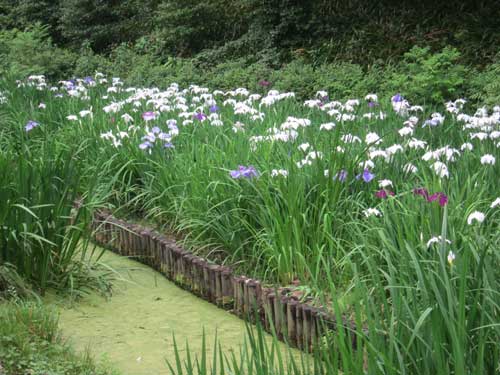
I was surprised also to see so many stone lanterns disassembled. Perhaps they fell down during the East Japan earthquake, and it’s prudent to leave them down in case of after shocks.


In Nihonbashi, you can still see a few old trees preserved alongside rare, pre-war government and corporate buildings.
日本橋には、昔から生き残っている木がまだ少しある。そのわきに、戦前に建てられた政府や企業のビルがある。
Recently I spoke with Canada’s Discovery History channel filmmakers about urban planning in Tokyo, and they requested that we film at Nihonbashi. What was once the center of Edo Japan is now buried beneath an elevated freeway. I used this opportunity to explore Nihonbashi’s surroundings, and came across some interesting government and corporate trees. These sites were not included in the filming, but I found them interesting.
The giant pines outside the old Bank of Japan building are very impressive. While the structure is partly covered in blue tarp and seems unused, the elegant landscaping with more than a dozen, perfectly pruned trees looks magnificent.

I was also impressed to see Mitsubishi’s river-side warehouse at the Edobashi crossing. This building, too, seems to have survived the great Kanto earthquake and the United State firebombing during World War II. In Tokyo, buildings are constantly raised and rebuilt, which almost always means destroying the old landscapes. It’s interesting to spot a few examples of building preservation that also protect older trees and landscapes.
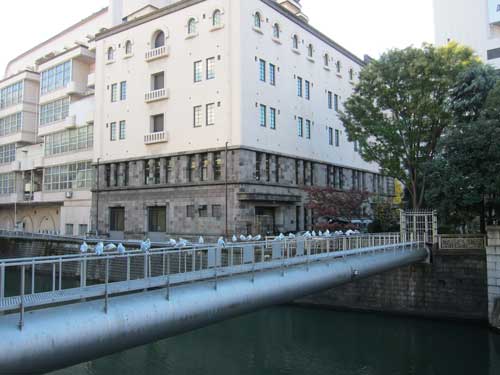
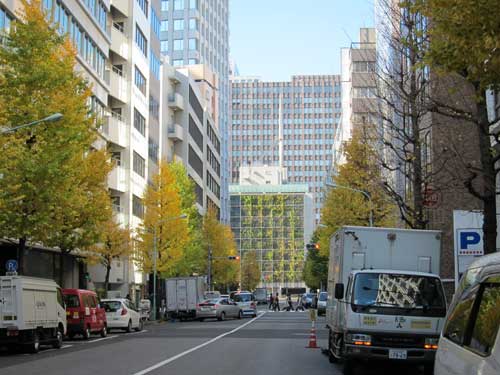
高層オフィスビルの垂直な庭はオフィス街を活気のある場所にする。
One office tower’s vertical garden brings new life to Tokyo’s business district.
Pasona’s headquarter’s vertical garden is filling out and bringing new life to the crowded office streetscape between Nishonbashi and Tokyo Station. The lushly planted wall includes many traditional Japanese garden plants and imports such as blueberry bushes. I like how it contrasts with the surrounding office towers, from the 1980s to recent years, and demonstrates that the potential for office wall gardens to benefit everyone inside and outside the building.
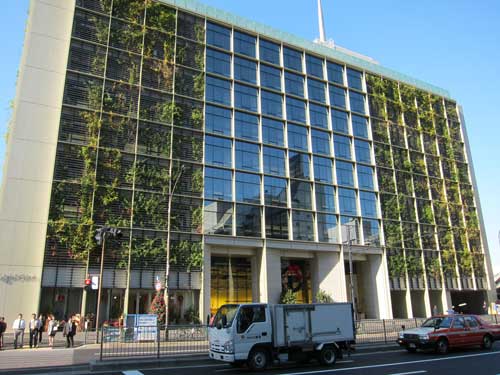
It’s amazing how much the garden has grown since I last visited Pasona in May. I am very excited to see this corporate garden become a landmark in the Yaesu district. It would be great for Mori or Mitsubishi to follow this example and experiment with vertical gardens and wildlife habitats on much taller Tokyo buildings. I also hope that Pasona continues to innovate with its urban landscape. Sidewalk gardens? More fruit trees? Butterfly hatcheries? Honeybees? Falcon’s nests?
Below are some details photos, including leaves that have turned red this fall, and some late-in-the-year pink roses.

